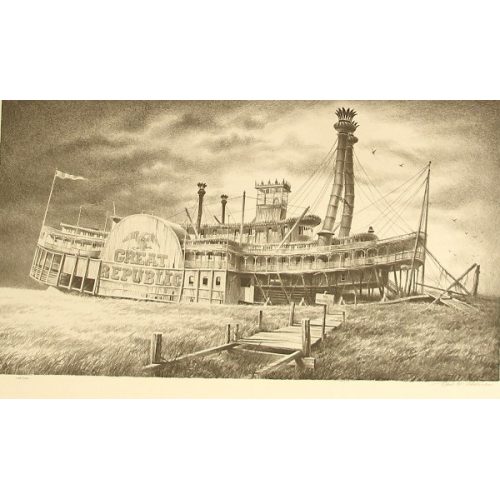
Boise, ID United States – 1924
The first thing that will strike the viewer is the light- an illumination that few painters can master. Then the remarkable details will begin to sink in. Not a stone, brick, branch, or shadow is overlooked- producing mesmerizing, hypnotically subtle images that immediately create an awareness of mood, mystery and atmosphere in an incredibly realistic and imaginative technique. It was his masterful use of light that made his work new and exciting and lifted him above the technical brilliance he shared with others- consequently separating his works from that of other realists. His extraordinary talent led renowned artist LeRoy Neiman to call him “the greatest realist of his time.”
The artist whose considerable talent is described in the preceding paragraph is the late Robert William Addison, a Chicago based artist for over 40 years. Born on January 17, 1924 in Boise, Idaho. Mr. Addison originally intended to become an architect. Fortunately for the art world his plans were sidetracked when he joined the Army right out of high school. After a training maneuver injury, Mr. Addison occupied his recovery time painting. The Red Cross sponsored a show of his works in which all of his paintings were sold, providing Mr. Addison with the confidence to pursue a career as an illustrator. Fate struck again in 1948, as post war America was flooded with people wanting to become illustrators. Finding classes filled, Mr. Addison turned to Chicago’s School of the Art Institute where he intensified his commitment to fine art. With encouragement from teacher Paul Wiegard, Mr. Addison was introduced to the Dutch and Italian Renaissance Masters he grew to admire- especially Bernardo Bellotto whose scenes depicting topographical precision and architectural structures would inspire his own work. Intrigued by Mr. Addison’s intense loyalty to realism, especially during a time when abstraction was in style, Wiegard provided individual instruction 3 days a week, challenging young Addison to study the technical excellence of the masters.
During his time at the Art Institute Mr. Addison came to recognize that he could organize his artistic gifts with such virtuosity that he could imitate any past form of painting style or expression, including the masters he so admired. But those artists had, in his opinion, exhausted their respective forms in the appropriate style and manner for their time. And while imitation may have been flattery to the old masters and the ability to carry it off a tribute to Mr. Addison’s talent, it wasn’t a vehicle that would distinguish or further his development as an artist. To that end Mr. Addison returned to the experiences and perceptions that turned him to art in the first place and gave him vision: his youth. From his days as a boy growing up in Idaho he had gained an unshakable appreciation of the landscape and, more importantly, the play of light on the plains and mountains that had an almost mystical effect on his imagination. According to the artist “the fall of light and shadow is the core of my work.” It is meaningful to note that it was the fundamental experiences and impressions culled from his formative years that so strongly influenced Mr. Addison to organize his work around that dynamic equation of light and shadow; the specter of darkness and shadow as it is penetrated by light.
As a foreshadowing of his eventual style, Mr. Addison’s early works collectively contain characteristic elements which would appear throughout his career: architectural forms, value, illusion of space, dynamic angles and rhythmic patterns. El Tracks (1949) and Man With Cart (1950, oil) are excellent examples of Mr. Addison’s early works and clearly reflect the influence the Ashcan school had at that stage. Like Andrew Wyeth, Peter Hurd, and Charles Burchfield, Mr. Addison gravitated towards a style that paid homage to American character with portrayals of American scenes, people, and places. A monumental piece, El Tracks focuses on the theme of man and his struggles in the unfriendly city. The light that penetrates the scene is spectacularly conceived, almost pulsating as it suggests the movement of the harried crowd of commuters. The power of this piece is nearly overwhelming in its barely contained energy and is considered by many to be one of the greatest realist paintings of the 20th century.
ROBERT ADDISON
Showing the single result
